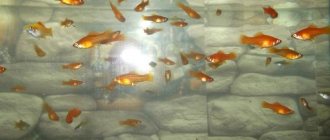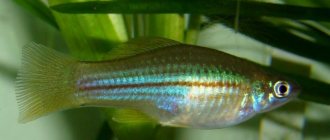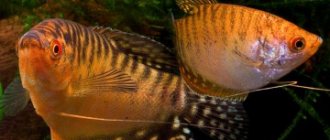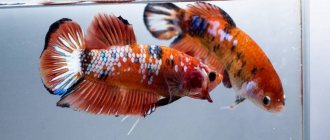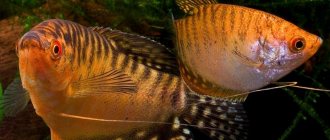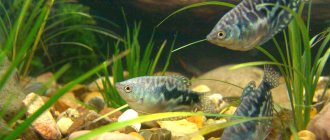Structure, appearance of gourami
Threadbearers or simply gourami are small fish, the length of which varies between 5-15 cm. Serpentine gourami in nature can reach 20-25 cm. Other species are up to 15 cm, but in an aquarium these fish almost never exceed 10 cm in length.
Beautiful and inquisitive gouramis from the labyrinth fish family are very popular among aquarists. They are quite unpretentious in care, they reproduce quite easily, since these fish tend to take care of their offspring. If the maintenance of gourami meets all standards, then the fish will be able to please your eyes for 7 years. That is why it is difficult to find an aquarium owner who has never introduced them into his pond.
The genus Gurami includes 6 species. The name Trichogaster (having threads on the belly) was given to the fish due to the thread-like fins located on the bellies of the fish, which serve as organs of touch and help to navigate in polluted waters with poor visibility.
The word "Gourami" in the Javanese language is used to refer to fish that stuck their "nose" out of the water.
Several decades ago, the name “threader” was used even more often than “gourami”. Often, “gourami” refers specifically to representatives of the genus Trichogaster.
Gourami breathe atmospheric air using a special organ - a labyrinth.
A couple of interesting facts
The larger the volume of the aquarium, the larger the gouramis grow.
If the so-called whiskers of these labyrinths, or rather the pectoral fins, break off for some reason, then they are capable of growing back.
As we can see, gourami are easy to keep, beautiful, and their habits are interesting to watch. I think that they can decorate any home pond, and especially the aquarium of a novice fish lover.
TYPES OF BARBES: PHOTO, NAMES, DESCRIPTION
TERNETIA CARAMEL: CARE AND MAINTENANCE IN THE AQUARIUM, PHOTO
PECILIIA MICKEY MOUSE: CONTENT IN THE AQUARIUM, PHOTO
PECILIIA HAWAIIAN: CONTENT IN THE AQUARIUM, PHOTO
PECILIA RADISH: CONTENT IN THE AQUARIUM, PHOTO
HOMALOPTERA CONFUSON: CONTENT IN THE AQUARIUM, PHOTO
BOTIA PULCHRA: CONTENT IN THE AQUARIUM, PHOTO
ACANTHOCOBIS UROPHTHALMUS: CARE AND MAINTENANCE, PHOTO
10 MOST UNWANTING AQUARIUM FISH
FUGU FISH: DESCRIPTION, PHOTO, POISONOUS OR NOT, CONTENT IN THE AQUARIUM
LEAF FISH: DESCRIPTION, CARE AND MAINTENANCE IN THE AQUARIUM, PHOTO, REPRODUCTION
MUD JUMPER: DESCRIPTION, CARE AND MAINTENANCE IN THE AQUARIUM, PHOTO
SPRAY FISH: DESCRIPTION, CONTENTS, BREEDING, PHOTO, VIDEO
10 BEST AQUARIUM FISH FOR BEGINNERS
Habitat of gourami
These fish live in Southeast Asia (the Malay and Indochina peninsulas, the islands of Sumatra, Kalimantan) in the reservoirs of the Antilles in Central America.
The widest range is that of the spotted gourami. It lives over a vast territory, ranging from India to the Malay Archipelago. The Spotted Gourami comes in many color variations.
Pearl gourami lives everywhere on the islands of Borneo and Sumatra.
There is evidence that this species can be found on the island of Java. These fish can also be found near Bangkok, the reason for their appearance here is aquarists who release fish into open waters.
Moon gourami Trichogaster microlepis lives in Thailand and Cambodia. Serpentine Trichogaster pectoralis - in Eastern Thailand, southern Vietnam, Cambodia. Blue - in Sumatra.
The range of the serpentine is close to the ocean coast opposite Sri Lanka. It is not native to the island, but it has already successfully colonized the waters of the Antilles in Central America.
In addition, these fish are found in stagnant bodies of water, flowing waters of rivers, and streams that are seemingly unsuitable for life. Some species, such as spotted and brown gourami, tolerate slight increases in water salinity and are found in estuaries of rivers flowing into the ocean in tidal zones.
Diseases
Despite the endurance and unpretentiousness of the fish, gourami is often plagued by diseases. If the fish lies on the bottom or refuses food, then these are sure signs of an approaching illness. The most common diseases in gourami are:
- Dropsy - develops due to a lack of oxygen in the tank. The situation can be corrected by improving the aeration of the reservoir.
- Invasive diseases - hexamitosis and ichthyosporidiosis. Infected pets become restless, gourami fish rub against the surface, and body weight decreases.
- Lymphocystosis - develops as a result of infection with parasites or due to mechanical damage. Treatment is usually not required, and recovered pets acquire immunity.
- Ligulosis - the cause of infection is poor-quality food. If a gourami has a swollen belly and loss of appetite, then most likely it is ligulosis.
- Aeromonosis is a characteristic disease of pearl gourami, which occurs when a reservoir is overpopulated. The symptoms of aeromonosis are as follows: the scales become ruffled, the pet loses weight, lies on the bottom from powerlessness.
Gourami are cheerful and active fish, which are a pleasure to keep. Unpretentiousness, abundance of species and colors, peacefulness are only a small part of the advantages for which aquarists love gourami species, and nimble and nimble pets pay their owners the same.
History of the discovery of gourami
Zolotnitsky N. F.;
P. Carbonnier and Meshchersky A.S. Pierre Carbonnier, a scientist from France, studied the issues of acclimatization of tropical fish in Europe. The species he was interested in included gouramis, medium-sized fish that constantly rise to the surface of the water. Despite the fact that gouramis were caught on different islands, the fish could not survive more than a day on the road. This was due to the fact that the fish were transported in wooden barrels, the top of which was completely closed to avoid water splashing out; this cut off the fish’s access to oxygen, which they could not do without, but no one knew about this yet.
Dozens of attempts were unsuccessful, and the fish were classified as problematic for transportation, stopping their distribution for more than 20 years.
Only at the end of the 19th century, one European, observing the behavior of gourami, noticed that from time to time they rise to the surface of the water to swallow a portion of air. Then he tried to transport the gourami again, but he filled the barrels with water less than halfway and did not additionally cover them with a lid. Thus, more than 1000 fish appeared in Europe for the first time and became very popular.
Varieties of gourami
As mentioned above, “gourami” are four species from the genus Trichogaster:
The spotted gourami is an energetic and fairly large silver-colored fish with spots on the tail and subtle dark stripes.
Brown gourami. The body length of this fish can easily reach 16 cm in aquarium conditions, so it can rightfully be called the largest representative of the entire species. Despite its size, the serpentine (brown) gourami is a peace-loving fish that does not really like bright light.
The pearl gourami gets its name from the small white spots that look like pearls, which are located on the body of the fish.
Moon gourami has a silver body with a greenish tint. Males have a faint orange tint on their ventral fins.
Gourami also includes closely related species, for example:
The kissing gourami was named so due to its interesting form of behavior. Sometimes the fish come up to each other, swim side by side, and then at one moment lock their mouths. In fact, this is not “love” at all, but an attempt to establish one’s social status in the pack;
Grunting gourami - the name speaks for itself: the fish makes grumbling sounds reminiscent of the croaking of a frog. “The Grumpy” emits them while in an excited state, swimming at night to the surface of the water to capture the next portion of air;
The dwarf gourami is a miniature fish compared to its relatives, which grows no more than 4 cm;
Honey gourami is unpretentious. It got its name due to its color. Females and young fish are silver-brown in color with a chocolate stripe along the body. Adult males are honey-colored, the underbelly, head, and most of the anal fin are black-brown. The dorsal fin has a white and yellow border. Because a female and a male of different colors, at first it was believed that these were representatives of different species.
You should know that there are color varieties of spotted gourami: blue, gold, marbled, etc.
blue gourami
golden gourami
marble gourami
Compatibility of different representatives in one aquarium
Most gourami representatives have a calm, peaceful disposition. Therefore, it is better to add fish with the same peaceful character to them.
The best neighbors for thread bearers will be:
- neons;
- minors;
- rasboras;
- Ancistrus;
- small cichlids;
- corridors.
In one aquarium you can keep several species of labyrinths that do not conflict with each other: honey, pearl, dwarf. But among the Nite-carriers there are individuals who are distinguished by their hostility towards their relatives. For example, blue, marbled, moon gourami. Most often, adult males enter into confrontation. Therefore, it is recommended to keep a flock in which there is 1 male for every 3-4 females.
Representatives of some species are sometimes aggressive towards smaller fish. Especially if the aquarium is cramped. The problem can be solved by transplanting the fish into a larger container and equipping it with more shelters.
Each type of gourami is unique. But any of them will decorate the aquarium without causing much trouble to the owners.
Conditions of detention
Although gourami are easy-to-care fish, you should still study the peculiarities of their maintenance in order to avoid problems.
- Water. The water temperature should not be lower than 25-27°C; during spawning the temperature can reach 28-30°C. If the water is colder, the fish may get sick. Be sure to install a thermostat to strictly control the temperature. Regarding hardness, gouramis are not very demanding, but the optimal parameters are slightly acidic water (pH = 6.0-6.8) and hardness up to 10° dH. The volume of the aquarium for these fish is from 50 liters, depending on the size of the adults and the number.
- soil , combining it with bright lighting (the only exception is if you are the owner of a brown gourami). the light from above, and also, if possible, it is necessary to provide the aquarium with access to daylight. The combination of such soil and good lighting will allow the fish to feel comfortable and acquire the most saturated color.
- Aquarium volume. For gourami, space and freedom of movement are very important. Based on this, it is unwise to stock them in an aquarium of less than 50 liters. The top of the home pond should be covered with glass, because the fish are quite jumpy, but you should always remember about their dependence on atmospheric air.
- Filtration. For gourami, it is important to provide good filtration, but one in which there is no strong flow of water. This is due to the fact that in their natural environment, most species choose bodies of water with standing water. Aeration improves the proper functioning of the nitrogen cycle, while gourami can easily do without it.
- Plants. For gouramis, it is very important that the aquarium contains live plants, which should be planted in groups, creating densely planted islands, leaving space for swimming. In dense thickets, timid fish can hide if necessary. It is advisable to purchase plants floating on the surface of the water, such as pistia, riccia. Thanks to them, the bright light will be dimmed, which will create a comfortable environment for males during spawning. They will build bubble nests. Please note that there should not be a lot of floating plants and they should not interfere with the fish swallowing air from the surface.
The color of a gourami indicates the health of the fish: under good housing conditions, and accordingly good health, the color will be rich; in females it is slightly less bright than in males.
What they look like
They are characterized by the same body structure. Subspecies can differ from each other in size, color, life expectancy and smaller features.
Gourami looks like a slender, laterally dense fish. The long anterior pelvic fins perform a tactile function. The body has an oblong, but at the same time not very elongated shape. Many gourami are distinguished by their brightly colored bodies, the most beautiful ones worth noting are pearl and honey. The description of gourami habitats is similar for all varieties; these are rivers and streams, poorly saturated with oxygen. Due to living in poor-quality water with little oxygen, they developed an epibranchial organ and a labyrinthine apparatus. Thanks to this, they can do without air for a long time.
Feeding
Gourami are unpretentious eaters: they can eat dry, live, or frozen food. They readily eat food with plant additives. They love small floating plants such as duckweed. Therefore, when drawing up a feeding plan, you need to take this into account.
Dry food can be presented in the form of granules, flakes, tablets, discs, etc. The only thing worth remembering is that the small mouth of these fish will not allow them to eat large foods - they will need to be crushed first.
Live and frozen food, such as brine shrimp, bloodworms, tubifex, aulophorus, daphnia, for large fish - gammarus. It is important to remember that constantly feeding fish with high-protein foods leads to obesity and subsequent death. In order to prevent this, the diet should be complete and varied. A fasting day is also necessary, once a week.
Adult gouramis, like many other fish species, can easily live 1-2 weeks without food. Therefore, such aquarium inhabitants can be safely acquired by those who are constantly traveling or at work. This is only possible with proper maintenance, when the fish are healthy and do not show signs of exhaustion.
Reviews
I have a male and female pearl gourami in my aquarium. Calm, beautiful. They live with a flock of neons. True, before spawning the male becomes cocky - he keeps his neighbors at bay. They are not picky about care. Lisa, 29 years old, Petropavlovsk
Six months ago I bought 4 gura. Among them were 2 bully males. I had to give one to my acquaintances who love aquarium fish. Since this was my first experience in breeding, I made several unforgivable mistakes in raising fry. Almost all died due to improper feeding. It turns out that on the 3rd day of birth they had to be fed ciliates not 2 times a day, but up to 8 times. And on the 6th day, switch to artemia - it is larger and more nutritious. In addition, during feeding it is necessary to turn off the aeration. Now, having gained experience, I know that fry can be treated with boiled egg yolk diluted in water. In general, I hope for success. Alexey, 45, Simferopol
I lived with a male and 2 female kissing gourami. Caring for them is not difficult. While they were young, they coexisted peacefully with catfish, angelfish, and neons. During the spawning period, the male behaved aggressively. It was necessary to transplant him and the female into a separate vessel. After laying the eggs, she returned them to the previous aquarium. With age, the character of a kissing gourami deteriorates and becomes aggressive. The oldest fish lived to be 7 years old in a separate aquarium next to only one speckled catfish. Nikolay, 65, Kurgan
Reproduction and breeding of gourami
Fish breeding is primarily associated with the choice of offspring producers. The main thing you need to learn is to distinguish a male gourami from a female. Mature fish are quite easy to distinguish by the shape and size of the dorsal fin. In females it is round and short, but in males it is pointed and quite long.
Gouramis become sexually mature when they reach the age of 8-12 months. In favorable conditions, females can spawn up to 5 times per season with an interval of 1-2 weeks, after which the fish need to take a break.
About one to two weeks before spawning, the spawners should be placed in individual aquariums with plentiful feeding of high-protein and live food. At this time, it is also advisable to prepare a separate container for spawning - an aquarium with a volume of 25-30 liters. There is no need to use soil in it, but it is still worth laying out shelters instead for a female who wants to get rid of the male’s advances.
The spawning aquarium must be filled with water taken from a common aquarium - 2 parts, another 1 part is fresh, clean water (you can use soft water, this additionally stimulates the fish to spawn). Its level should be at 15 cm.
It is not worth installing powerful filters and aeration equipment: they can destroy the nest that the male builds during spawning.
Reproduction process
The male is the first to enter the spawning area. The temperature in the container is raised to 28-29°C and about 30% of the water is replaced with softer and fresher water. Thus, the natural conditions in which gourami breed during the period of heavy tropical rains are recreated.
The male then builds a nest for his offspring. It can reach 5 cm in size and is built from the male’s saliva, pieces of plants and air bubbles. The erection process itself takes about a day, after which the male invites the female to spawn.
The male swims, trying with all his might to attract the female. When this is successful, he drives it into the nest and they try to “squeeze” the eggs out of it. The eggs, which are lighter than water, immediately end up on the surface of the aquarium, from where the fish collect them with their mouths and carefully place them in the nest. If the male has not built a nest, they remain on the surface of the container.
After spawning, the female should be removed from the spawning area, because the father will take care of the offspring: he will collect the fallen eggs and return them to their place, and at the same time remove unfertilized or spoiled ones. It is important at this time to disturb the male as little as possible by changes in the composition of the water, excessive curiosity and any manipulations in the aquarium, as he may give up caring for the children.
The difference between a female and a male
Male and female gourami differ markedly from each other. Here are the main distinguishing features:
- the male is always larger and slimmer than the female;
- the male is colored brighter and more contrasting;
- its fins are longer;
- The dorsal fin of the male is elongated, while that of the female is rounded.
